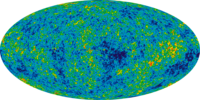
Photo from wikipedia
We investigate the time evolution of dense cores identified in molecular cloud simulations using dendrograms, which are a common tool to identify hierarchical structure in simulations and observations of star… Click to show full abstract
We investigate the time evolution of dense cores identified in molecular cloud simulations using dendrograms, which are a common tool to identify hierarchical structure in simulations and observations of star formation. We develop an algorithm to link dendrogram structures through time using the three-dimensional density field from magnetohydrodynamical simulations, thus creating histories for all dense cores in the domain. We find that the population-wide distributions of core properties are relatively invariant in time, and quantities like the core mass function match with observations. Despite this consistency, an individual core may undergo large (>40%), stochastic variations due to the redefinition of the dendrogram structure between timesteps. This variation occurs independent of environment and stellar content. We identify a population of short-lived (<200 kyr) overdensities masquerading as dense cores that may comprise ~20% of any time snapshot. Finally, we note the importance of considering the full history of cores when interpreting the origin of the initial mass function; we find that, especially for systems containing multiple stars, the core mass defined by a dendrogram leaf in a snapshot is typically less than the final system stellar mass. This work reinforces that there is no time-stable density contour that defines a star-forming core. The dendrogram itself can induce significant structure variation between timesteps due to small changes in the density field. Thus, one must use caution when comparing dendrograms of regions with different ages or environment properties because differences in dendrogram structure may not come solely from the physical evolution of dense cores.
Journal Title: Monthly Notices of the Royal Astronomical Society
Year Published: 2020
Link to full text (if available)
Share on Social Media: Sign Up to like & get
recommendations!